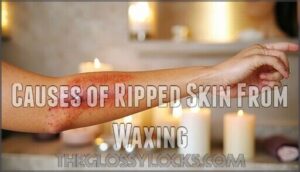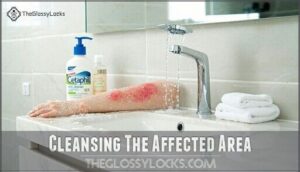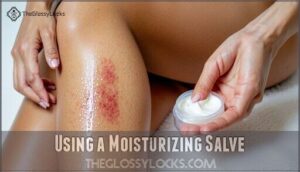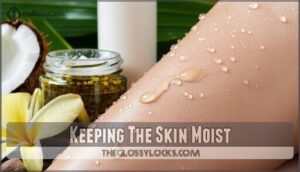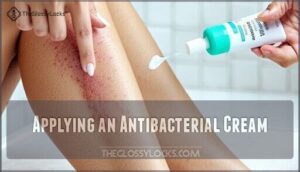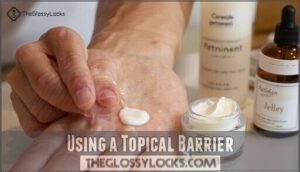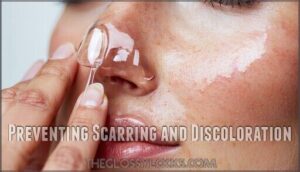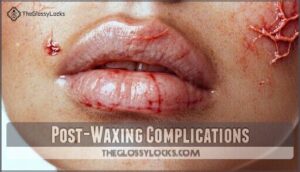This site is supported by our readers. We may earn a commission, at no cost to you, if you purchase through links.
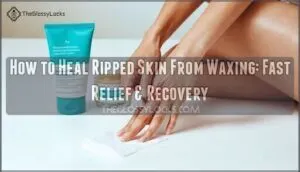
First, gently cleanse the area with lukewarm water and pat dry—no rubbing allowed. Apply a thin layer of antibiotic ointment like Neosporin to keep bacteria at bay.
Next, slather on a moisture barrier cream to create a protective shield while your skin repairs itself. Think of it as wrapping your wounded skin in a cozy blanket.
Keep the area covered with a sterile bandage if needed, and resist the urge to pick or scratch. The key is maintaining moisture while preventing contamination.
Your skin’s natural healing process works best when it’s not fighting off germs or drying out. With proper care, most minor tears heal within a week. However, knowing which products work best and understanding the warning signs of complications can make all the difference in your recovery timeline.
Table Of Contents
- Key Takeaways
- Pre-Waxing Precautions
- Causes of Ripped Skin From Waxing
- Immediate Post-Wax Care
- Healing and Repairing Ripped Skin
- Preventing Scarring and Discoloration
- Post-Waxing Complications
- Long-Term Care and Maintenance
- Frequently Asked Questions (FAQs)
- What to put on a skin tear from waxing?
- Why is my wax ripping my skin off?
- Does vaseline heal wax burns?
- How to heal skin damage from waxing?
- How to correct impacted ear wax?
- How long does skin ripped from waxing take to heal?
- Can waxing cause tearing or ripping of the skin?
- How long does ripped skin from wax take to heal?
- How to fix damaged skin from waxing?
- What do you put on raw skin after waxing?
- Conclusion
Key Takeaways
- Clean ripped skin gently with lukewarm water, then pat dry—don’t rub or scrub.
- Apply antibiotic ointment and a moisture barrier cream to keep the area protected and hydrated.
- Cover with a sterile bandage if needed, and don’t pick or scratch the wound.
- Watch for signs of infection like redness, swelling, or discharge, and seek medical help if they appear.
Pre-Waxing Precautions
Taking precautions before waxing can save you from the painful experience of ripped skin that requires days or weeks of careful healing.
You’ll want to avoid certain medications, disclose health conditions to your esthetician, and properly prepare your skin to minimize injury risk.
To ensure a safe waxing experience, it is essential to follow these steps carefully, as they can help prevent painful complications.
Health Conditions to Avoid Waxing
Before waxing, certain health conditions make your skin more vulnerable to complications.
If you have any of these conditions, skip waxing to prevent serious skin damage:
- Blood thinners – Medications like warfarin increase bleeding and bruising risks
- Diabetes risks – Poor healing and higher infection rates make waxing dangerous
- Autoimmune diseases – Conditions like lupus weaken your skin’s protective barrier
- Skin conditions – Eczema, psoriasis, or rosacea can flare up dramatically after waxing
For diabetics, waxing can offer longer lasting hair removal compared to shaving.
Medications to Avoid When Waxing
Your skin’s vulnerability skyrockets when certain medications thin its protective layers.
Retinoid risks include tretinoin and adapalene, which increase skin sensitivity dramatically. Blood thinners like warfarin cause excessive bleeding when skin ripped from waxing occurs.
Here’s what amplifies your skin sensitivity:
- Accutane concerns – Oral isotretinoin disrupts skin barrier function completely
- Steroid use – Topical corticosteroids weaken skin structure substantially
- Antibiotic sensitivity – Doxycycline and tetracycline reduce natural resilience
- Blood thinners – Aspirin and heparin increase bruising risks
- Retinoid risks – Stop these seven days before waxing appointments
Importance of Client Disclosures
Beyond simply showing up for your appointment, sharing your medical history and medication awareness creates a safety net that prevents skin sensitivity disasters.
You’ll need to discuss product usage like retinoids, recent peels, or chemical treatments that thin your skin. Your esthetician can’t read minds, so informed consent means revealing everything from Accutane to allergies.
Skin Allergies
Medications
Past Treatments
Informed Consent
This transparency prevents how to heal ripped skin situations before they start.
Causes of Ripped Skin From Waxing
Understanding why skin rips during waxing helps you avoid this painful mishap and heal faster when it happens.
Several common factors can cause your skin to tear, ranging from technique errors to preparation mistakes, and understanding these factors is crucial to preventing skin tears.
Using The Wrong Wax Temperature
Hot wax can quickly turn your hair removal session into a painful nightmare.
When wax temperature exceeds safe levels, you’re risking serious skin burns and tissue damage that goes beyond simple redness.
Safe wax heaters maintain consistent temperatures, preventing the scorching that causes waxing skin damage.
Always test wax on your wrist first—it should feel warm, not burning.
Proper temperature monitoring tips include using digital thermometers and allowing overheated wax to cool before application, which helps prevent serious skin burns and ensures a safe waxing experience with consistent temperatures.
Incorrect Wax Application Techniques
Temperature mistakes aren’t the only culprit behind waxing ripped skin. Poor technique causes just as much damage when you don’t follow proper protocols.
Here’s what goes wrong with faulty waxing techniques:
- Skin stretching failures leave loose skin vulnerable to tearing during removal
- Wax direction mistakes create uneven adhesion and incomplete hair removal
- Hair length issues prevent proper grip, forcing repeated passes over sensitive areas
- Technician skill gaps lead to rushed removal at wrong angles
- Skin lifting waxing occurs when strips pull upward instead of parallel
You’ll avoid skin adhesion problems by choosing experienced professionals who understand proper wax temperature control and removal techniques.
Proper skin preparation techniques remove oils and guarantee wax adherence.
Not Preparing The Skin Properly
Proper prewaxing preparation dramatically reduces your risk of skin lifting waxing incidents.
Many people skip vital steps, leaving their skin vulnerable to damage.
| Preparation Step | Why It Matters |
|---|---|
| Exfoliation Importance | Removes dead skin cells that interfere with wax adhesion |
| Hydration Levels | Well-moisturized skin stretches better, reducing tears |
| Skin Sensitivity Assessment | Identifies areas needing gentler wax type selection |
| Pre-cleansing | Removes oils and debris for ideal wax contact |
| Hair Length Check | Ensures proper grip without excessive pulling |
Without proper skin preparation, you’re setting yourself up for ripped skin after wax treatments.
Using Retinoids Before Waxing
Retinoids create a thinning effect on skin layers, making your epidermis vulnerable to damage during waxing sessions.
Retinoids thin your skin’s protective layers, leaving you defenseless against waxing damage.
Professional disclosure about retinol strength helps prevent skin tearing and ripping from occurring. Daily sunscreen use is important since retinoids increase skin’s sun sensitivity.
- Stop retinoid acclimation two weeks before your waxing timeline
- Avoid prescription-strength retinol to prevent severe skin damage
- Inform your technician about recent retinoid use for safety
Immediate Post-Wax Care
When you rip skin during waxing, you’ll need to act fast to prevent infection and promote proper healing.
Your first priority is cleaning the area gently, then applying the right treatments to protect and repair the damaged skin, which will help to prevent infection and ensure proper healing.
Cleansing The Affected Area
After wax removal gone wrong, your first priority is proper wound cleansing. Rinse the area with cold water to remove wax residue and debris. Use gentle cleansers like Cetaphil or mild soap for thorough skin cleansing.
Apply antiseptic solutions to reduce infection risk, then pat dry with sterile bandages or clean cloth. To further soothe the area, consider that witch hazel can help calm irritated skin.
| Cleansing Step | Recommended Products |
|---|---|
| Initial rinse | Cold water, saline solution |
| Deep cleaning | Gentle cleansers, mild soap |
| Disinfection | Antiseptic solutions, diluted alcohol |
| Drying | Sterile bandages, clean towels |
Applying Antibiotic Cream
After cleansing, antibiotic cream application becomes your next defense against infection.
Apply a thin layer of Neosporin or Bacitracin twice daily to support healing and prevent bacterial complications. Consider neosporin for skin repair following waxing sessions.
Here’s your cream application strategy:
- Clean hands first – wash thoroughly before touching the wound area
- Use pea-sized amounts – excessive cream won’t speed healing and may irritate
- Apply gently – pat don’t rub to avoid further skin trauma
- Cover if needed – sterile bandages protect from contamination and clothing friction
- Watch for reactions – discontinue if redness, itching, or swelling worsens
Using a Moisturizing Salve
Following your antibiotic cream application, you’ll want to heal skin after waxing with a protective moisturizing salve.
These ripped skin treatment products create a barrier that locks in moisture while promoting post wax skin repair.
| Salve Benefits | Details |
|---|---|
| Specific Salves | Vaseline Petroleum, Cerave Healing Ointment |
| Salve Ingredients | Petrolatum, ceramides, hyaluronic acid |
| Application Frequency | 2-3 times daily until healed |
| Homemade Salves | Coconut oil mixed with aloe vera gel |
| Waxing Wound Care | Forms protective seal against bacteria |
Many people find relief using a quality post-wax salve.
Apply gently to treat ripped skin without rubbing.
Applying Sunscreen
After moisturizing your damaged skin, sun protection becomes your next priority.
Your freshly waxed area is vulnerable to ultraviolet radiation damage, making proper sunscreen application critical for healing and skin cancer prevention.
Apply these sunscreen application tips for maximum protection:
- Choose broad spectrum SPF 30 or higher for complete ultraviolet radiation coverage
- Select mineral sunscreen benefits like zinc oxide for sensitive, compromised skin
- Follow sunscreen reapplication frequency of every two hours outdoors
- Avoid sunscreen and makeup combinations that might irritate healing skin
- Apply generously before any sun exposure risks occur
Healing and Repairing Ripped Skin
When waxing rips your skin, you’ll need to focus on three essential healing steps to repair the damage and prevent complications.
Proper moisture, antibacterial protection, and barrier application work together to speed recovery and minimize scarring risk.
Keeping The Skin Moist
Proper hydration importance becomes your skin’s best friend after a skin tear after waxing.
Plant-based oils like coconut or olive oil work wonders for damaged skin repair, creating a protective barrier that locks in moisture.
Choose moisturizer types with humectants benefits and occlusive agents to support skin healing, this waxing aftercare ripped skin approach promotes faster moisturization and recovery.
Applying an Antibacterial Cream
Several antibacterial cream options can protect your wounded skin from harmful bacteria.
Apply Neosporin, bacitracin, or mupirocin twice daily using clean hands for ideal infection prevention. These antibacterial solutions create a protective barrier against skin infections while promoting faster healing.
Follow package directions for usage frequency and watch for allergic reactions or unusual side effects.
Proper cream application transforms basic wound care into effective recovery.
Using a Topical Barrier
Apply a topical barrier like petroleum jelly or ceramide creams to seal moisture and protect healing skin.
These barrier ingredients create a protective shield during the skin healing process, preventing irritants from disrupting wound care. Ceramides reinforce the barrier and are often found in effective creams.
- Vaseline or CeraVe Healing Ointment: Provides gentle, effective protection
- Lanolin application: Naturally soothes while creating barriers
- Ointment benefits: Locks moisture for ideal skin recovery
Preventing Scarring and Discoloration
Once you’ve treated the immediate trauma from waxing, your next priority is preventing permanent marks on your skin.
The right approach can mean the difference between smooth healing and lasting reminders of your waxing mishap, with the outcome depending on the right method used.
Using Bio Oil for Scar Prevention
Bio Oil delivers proven scar prevention benefits when you start early application on healed skin.
Its vitamin E formula accelerates skin repair and supports the natural skin healing process.
Gently massage two drops twice daily for ideal wound healing.
Bio Oil Benefits include reduced discoloration and improved texture.
Different Scar Type Matters – it works best on fresh, minor injuries.
Application Techniques matter: clean skin first, then apply thin layers.
Many users find it beneficial to reduce visible scars.
Long-Term Results appear after 8-12 weeks of consistent use.
Applying Strict Sunscreen
Sunscreen becomes your skin’s bodyguard after waxing trauma.
Choose SPF 30 or higher with broad-spectrum protection against harmful ultraviolet rays.
Apply generously every two hours, especially after sweating or swimming.
Here’s your sun protection game plan:
- SPF Level Matters – Use minimum SPF 30 for adequate UV protection
- Broad Spectrum Importance – Blocks both UVA and UVB rays effectively
- Sunscreen Application Frequency – Apply liberally 15 minutes before sun exposure
- Sunscreen Reapplication Timing – Reapply every two hours without fail
- Sunscreen Ingredient Safety – Choose mineral-based formulas for sensitive, healing skin
Avoiding The Sun
Beyond sunscreen, your skin needs a break from the sun entirely.
Stay indoors during peak sun hours (10 AM to 4 PM) when ultraviolet rays hit hardest.
Even brief sunlight exposure can trigger hyperpigmentation risks on healing skin.
Choose clothing coverage over SPF creams when possible – UV protection through fabric shields damaged areas better than topical applications alone, providing complete protection and reducing risks of further damage.
Post-Waxing Complications
Even careful waxing can sometimes lead to complications that require immediate attention and proper management.
You’ll need to recognize these issues early and take the right steps to prevent them from becoming serious problems.
Infection and How to Prevent It
After waxing tears your skin, bacteria can easily sneak in through open wounds. Ripped skin increases infection risk by up to 40% compared to intact skin.
Torn skin from waxing creates an open gateway for dangerous bacteria to invade your body.
One common issue to keep in mind is how to avoid ingrown hairs.
- Clean immediately: Use natural disinfectants or mild soap within one hour to reduce bacteria by 90%
- Apply antibiotic ointment: Topical treatments like bacitracin lower infection rates from 32% to 7%
- Monitor wound healing: Watch for redness, warmth, or yellow discharge indicating skin infection
- Use sterile bandages: Cover with breathable dressings and antiseptic creams for wound infection prevention
Ingrown Hairs and How to Prevent Them
Preventing ingrown hairs requires consistent skin care routines after waxing.
Regular exfoliation methods help remove dead skin cells that trap growing hairs beneath the surface.
Gentle skin exfoliation twice weekly keeps follicles clear and promotes healthy hair growth patterns.
Proper hydration importance can’t be overstated – moisturize daily to maintain skin flexibility.
Clothing choices matter too; loose-fitting garments prevent friction that causes irritation.
Skip tight yoga pants for a few days.
Maintain skin hydration with fragrance-free lotions, and establish a proper skincare routine that includes gentle cleansing and consistent moisture.
This routine is crucial for healthy hair growth patterns and overall skin health.
Long-Term Care and Maintenance
Once your ripped skin has healed, you’ll want to get back to your regular skincare routine while taking steps to prevent future waxing mishaps.
The key is building habits that keep your skin healthy and prepared for any future hair removal sessions, focusing on being prepared.
Resuming Normal Skincare Routines
Once your skin has healed from waxing trauma, you can gradually resume your normal skincare routine with careful attention to your skin’s needs.
Start with gentle products and monitor how your skin responds before introducing stronger formulations.
Gradual Resumption involves slowly reintroducing products to avoid overwhelming your recovering skin barrier:
- Gentle Exfoliation: Wait 48-72 hours before using mild exfoliants to remove dead skin cells
- Product Reintroduction: Add one new product every few days to monitor for irritation
- Hydration Focus: Prioritize skin moisturizers and gentle skincare to maintain ideal skin hydration
Practice Irritation Monitoring by watching for redness, burning, or increased sensitivity when resuming your skin care routine.
Avoiding Future Waxing Complications
Once you’re healed, preventing future waxing disasters becomes your top priority.
Choose skilled technicians who understand proper waxing techniques and perform patch testing for skin sensitivity. Select appropriate wax for your skin type and avoid retinoids beforehand.
Professional waxing techniques minimize complications, while consistent aftercare routines keep skin healthy between sessions.
Prevention Strategy Action
Technician Skill
Wax Selection
Skin Sensitivity
Maintaining Healthy and Hydrated Skin
Building on prevention strategies, focus on hydration importance for long-term skin health maintenance.
Establish a gentle cleansing routine using fragrance-free products that support dermal cell integrity.
Choose non-comedogenic moisturizers to restore skin integrity restoration without clogging pores.
Daily sun protection prevents damage while maintaining skin moisturization.
Remember, consistent water intake and nutrient-rich foods fuel your skin’s natural repair processes from within.
Frequently Asked Questions (FAQs)
What to put on a skin tear from waxing?
Apply cold compresses immediately, then clean with gentle soap and water. Use antibiotic ointment like Neosporin to prevent infection. Cover with sterile bandage and keep moisturized with petroleum jelly.
Why is my wax ripping my skin off?
Your wax might be ripping skin because it’s too hot, you’re using harsh retinoids beforehand, your skin’s overly dry, or improper technique’s being used during removal.
Does vaseline heal wax burns?
Like a soothing balm for battle-weary skin, Vaseline can help heal wax burns. You’ll find it creates a protective barrier, preventing infection while keeping damaged skin moist for faster healing.
How to heal skin damage from waxing?
Clean damaged skin gently with mild soap, then apply antibiotic ointment like Neosporin.
Use cold compresses for swelling and aloe vera for soothing.
Keep moisturized with fragrance-free products and avoid sun exposure until healed.
How to correct impacted ear wax?
You’ll need professional help for impacted earwax. Don’t use cotton swabs—they push wax deeper. Try over-the-counter ear drops to soften it first, then see a doctor for safe removal.
How long does skin ripped from waxing take to heal?
Healing time typically ranges from one to two weeks, depending on the severity of your skin damage.
You’ll notice improvement within days if you keep the area clean and moisturized properly.
Can waxing cause tearing or ripping of the skin?
Yes, waxing can definitely tear your skin. Poor technique, wrong wax temperature, sensitive skin conditions, or recent retinol use increase your risk of ripping during hair removal sessions.
How long does ripped skin from wax take to heal?
Your skin feels like it’s been through a tornado, but don’t panic—ripped waxing wounds typically heal within one to two weeks with proper care and monitoring for infection signs.
How to fix damaged skin from waxing?
Clean damaged waxed skin gently with mild soap and lukewarm water.
Apply antibiotic ointment like Neosporin to prevent infection.
Use aloe vera gel for soothing relief.
Keep moisturized with fragrance-free lotion.
Avoid sun, makeup, and tight clothing until healed.
What do you put on raw skin after waxing?
Apply antibacterial ointment like Neosporin, then cover with aloe vera gel.
Use a cold compress for ten minutes to reduce swelling.
Keep it moisturized with petroleum jelly or Aquaphor to prevent infection.
Conclusion
Wondering why proper aftercare matters so much?
Learning how to heal ripped skin from waxing correctly prevents complications that could last weeks instead of days.
Your skin’s recovery depends on consistent moisture, protection from bacteria, and avoiding sun exposure.
Don’t skip the antibiotic ointment or barrier cream—they’re your best defense against infection and scarring.
With patience and proper care, you’ll bounce back with smoother, healthier skin ready for your next waxing session.
- http://allaboutbrowandlash.com/wp-content/uploads/2019/09/Contraindications-of-Waxing.pdf
- https://www.serenityspatc.com/face-waxing-information
- https://tuelberodin.com/blogs/news/dos-and-don-ts-what-you-need-to-know-about-waxing-contraindications
- https://en.sinocare.com/blogs/diabetes/why-cant-diabetics-use-wax-strips
- https://waxhavensd.com/is-waxing-safe-if-i-have-a-medical-condition/

